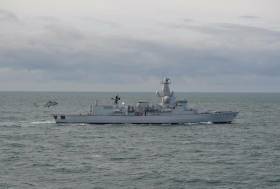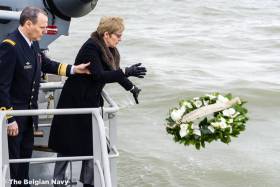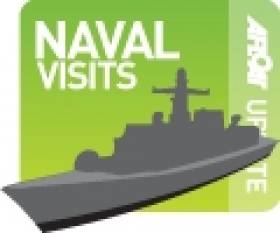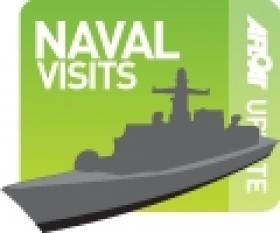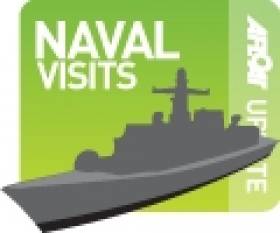Displaying items by tag: Belgium Navy
Trio of European Neighbouring Nation's Navies to Visit Dublin Port Over May Bank Holiday
#NavalVisits - Navies from neighbouring nations of France, Belgium and the Netherlands are to arrive in Dublin Port today in advance of the May Bank Holiday Weekend, with one ship from each navy visiting, writes Jehan Ashmore.
First to arrive is the French Navy's Éridan class minehunter Andromède (M 643) one of the 'Tripartite' vessels completed in collaboration of the three visiting navies to the Irish capital.
Already in the port to welcome the trio of European naval visitors is the Naval Service's OPV90 class L.E. William Butler Yeats (see story). The second of three 'Beckett' class sisters in service, arrived on Tueday and is berthed at Sir John Rogerson's Quay.
While across Dublin Bay, is where yesterday CPV L.E. Ciara docked in Dun Loaghaire Harbour where an unusual caller the ro-ro Stena Carrier underwent a survey. Some of the '4Runner' class sisters down the years have been chartered to the UK's Royal Fleet Auxiliary and NATO.
Returning to Dublin Port is where Andromède is to berth at Sir John Rogersons Quay closer to the centre of the capital. It was in the French capital yesterday where Minister for Agriculture Food & Marine, Michael Creed TD met his French counterpart, Stephane Travert.
Afloat adds during the French naval visit, the Association of Veterans of the Foreign Legion in Ireland meets for the annual commemoration of the Battle of Camarón. The ceremony this year will take place on the Bank Holiday Monday, 5 May at 11:45 am at Collins Barracks. This free event is open to all to attend at the venue close to the banks of the Liffey.
As for this morning, the Dutch Navy's HNMLS Evertsen (F805) is to make an appearance albeit docking at a deeper quay downriver. The vessel is the fourth De Zeven Provinciën-class frigate of the Royal Netherlands Navy.
The third visitor, the Belgian Navy's BNS Louise-Marine (F931) will arrive in the afternoon and is to berth next to Andromède. The final caller to the capital is the second of a pair of Karel Doorman-class frigates of the Belgian Maritime Component (the official name of the navy). The frigate commissioned in 2008 was acquired three years previously from the Netherlands Navy.
Belgium Navy 'Ready Duty Ship' On Extended Shore Leave Visit
#ReadyDutyShip – Afloat has an update to the Belgium Navy ship which docked in Dublin Port earlier this week having carried out a commemorative service on Monday. This was to mark the 30th anniversary of a UK-Zeebrugge serving ferry that capsized off the Belgium port.
The naval vessel BNS Castor, designated as a Ready Duty Ship (RDS) is one of the most modern of the Belgium Navy is based in Zeebrugge. It was from the country's main naval base that BNS Castor had departed to make an arrival in Dublin Port on Wednesday morning. The sleek 53m long BNS Castor built in 2014 has a maximum speed of 22 knots which is generated from diesel engines.
BNS Castor berthed on the Liffey along Sir John Rogersons Quay where one of the 15 crew members spoke to Afloat to emphasise the visit to Dublin was for an extended shore leave. The length of the crew and recreation leave away from routine North Sea patrols is for four days. Accompanying the naval visitor to the capital's port was L.E. Ciara which had berthed astern.
Among the duties of BNS Castor are search and rescue duties, surveillance of EEZ waters, illegal fishing control and fight against trafficking and pollution.
To assist these tasks, BNS Castor has a pair of RHIB craft, one 9m in length and the other measures 7.5 m. They are positioned towards the stern of the RDS where a cradle docking area has fast release equipped to enable rapid response during deployment missions. The vessel also features a panoramic (360°) bridge and an FN Herstal SeaDeFNder 12.7 mm remotely operated machine gun.
BNS Castor was commissioned by the Belgiam Navy to a French shipyard SOCARENAM for the RDS program for two vessels. BNS Castor was delivered in July 2014 and was followed by sister BNS Pollux in the first half of 2015.
#BelgiumNavy - A Belgium Navy ship is visiting Dublin Port, however the call to the capital follows a solemn occasion held on board to mark a ferry disaster that took place off Zeebrugge three decades ago.
On Monday the BNS Castor departed the naval base in Zeebrugge to commemorate the 30th anniversary of the Herald of Free Enterprise disaster outside the North Sea port.
On board the naval vessel was the British Ambassador to Belgium, Alison Rose who laid a wreath along with Belgium officials. The ceremony part of those held also on land, was to remember the 193 passengers who died when the Herald of Free Enterprise in 1987 capsized near the coast of Zeebrugge. The day also reflected on the Belgians who helped to save many lives.
The naval visit of BNS Castor to Dublin Port sees the 2014 built Ready Duty Ship (RDS) arrive with a 15 member crew. Among the roles they have are search and rescue (SAR) and surveillance operations undertaken by the vessel in the European Economic Zone (EEZ).
Presenting a sleek profile on the Liffey was the 53m BNS Castor that was escorted by the tug Shackleton and pilot cutter Dodder. This involved the naval ship take a berth close to the city-centre along Sir John Rogersons Quay at berth No. 8. This berth is typically allocated to such foreign naval vessels, tallships and small cruiseships.
Belgium Navy’s Cork Call Joined by UK ‘Duke’ Class Frigate
#VisitngNAVIES – As previously reported the Belgium Navy's minehunter BNS Primula (M924) and auxliliary BNS Stern are visiting Cork which saw today the vessels berth along Cork City Quays, writes Jehan Ashmore.
In addition the Royal Navy's Duke-class frigate HMS Northumberland (F238) is also paying a visit with the 4,000 displacement frigate at anchorage in lower Cork Harbour.
Accompanying the Belgium Navy vessels upriver to Cork City were the LE Eithne and LE Aisling which are berthed nearby.
HMS Northumberland has a crew of more than 185 personnel and along with two of her sisters last month sailed into London to support a variety of maritime events. The 'Northumberland' was present at the inaugural London International Shipping Week conference held in Canary Wharf.
Her sisters HMS Sutherland and HMS Tyne moored at the Royal Docks outside ExCel as part of the DSEi defence and security exhibition, providing delegates with a visible demonstration of naval power and capability.
Belgium Minehunter Visits Cork following call by Dutch Submarine
#MineHunter – Following last week's notable visit of Dutch submarine HNMLS Dolfijn (S808) to Cork City Quays, the Belgium Navy's minehunter BNS Primula (M924) is currently at anchorage in the lower harbour, writes Jehan Ashmore.
Accompanying the BNS Primula is the auxiliary vessel BNS Stern (A963) which is also anchored in Cobh Roads.
BNS Primula is a Tripartite-class minehunter and forms part of the Belgian Naval Component and she has a 595 tonnes displacement. She was launched in 1990 at the Mercantile-Belyard shipyard in Rupelmonde.
The Tripartite class vessel represents the final of ten of the series commissioned for the Belgian Navy. Neighbouring nations Netherlands and France completed the Tripartite partnership in the design and development of the class.
Tripartite class vessels from these nations have been regular visitors to Irish ports unlike the rare sight of a submarine in an Irish port as demonstrated by HNLMS Dolfijn.
The submarine's visit was made more the unusual in that she could be clearly seen moored at the Cork city-centre berth rather than a downriver location which compared to some other Irish ports can be more discreet from public view.
The 'Walrus' class submarine had made the upriver transit of Cork Harbour to the city centre (click previous report and scroll down for footage) and is seen passing near Monkstown.
Tripartite Naval Visitors for Dublin Port
Naval vessels from France, Canada and Belgium are due to make calls to Dublin Port over the weekend, writes Jehan Ashmore.
The first visitor to dock tomorrow will be the Latouche-Tréville (D646) a F70 type anti-submarine frigate of the French Marine Nationale. She is one of seven F70 ASM class anti-submarine frigates and is capable of carrying two 2 Lynx helicopters. In June 2010 the frigate visited London where the 1984 built 3,550 tonnes vessel moored alongside the WW II cruiser, HMS Belfast.
Also due to arrive tomorrow is the Canadian Navy's HMCS St. John's which too is to berth at Ocean Pier. HMCS St. John's (340) is the eleventh 'Halifax' class frigate, measuring some 4,770 tonnes. The multi-role patrol frigate was commissioned in 1996 in St. John's, Newfoundland and is designed to perform three distinct functions: anti-submarine warfare, anti-air warfare and anti-surface warfare.
On Sunday the third international naval visitor to Dublin Port will be the Belgium Navy's Léopold I (F930). This frigate is based in the Quartier Naval Base in Zeebrugge and in 1997 she was commissioned into service in a ceremony by Belgium's Queen Fabiola.
The 2,800 tonnes frigate is capable of taking two helicopters and the vessel can cruise at 21 knots using two diesel engines or is capable of reaching a top speed of 30 knots based from gas turbine power-plants. Léopold I has participated in NATO's Response Force (NRF). For a detailed visual discription of equipment click this link here

